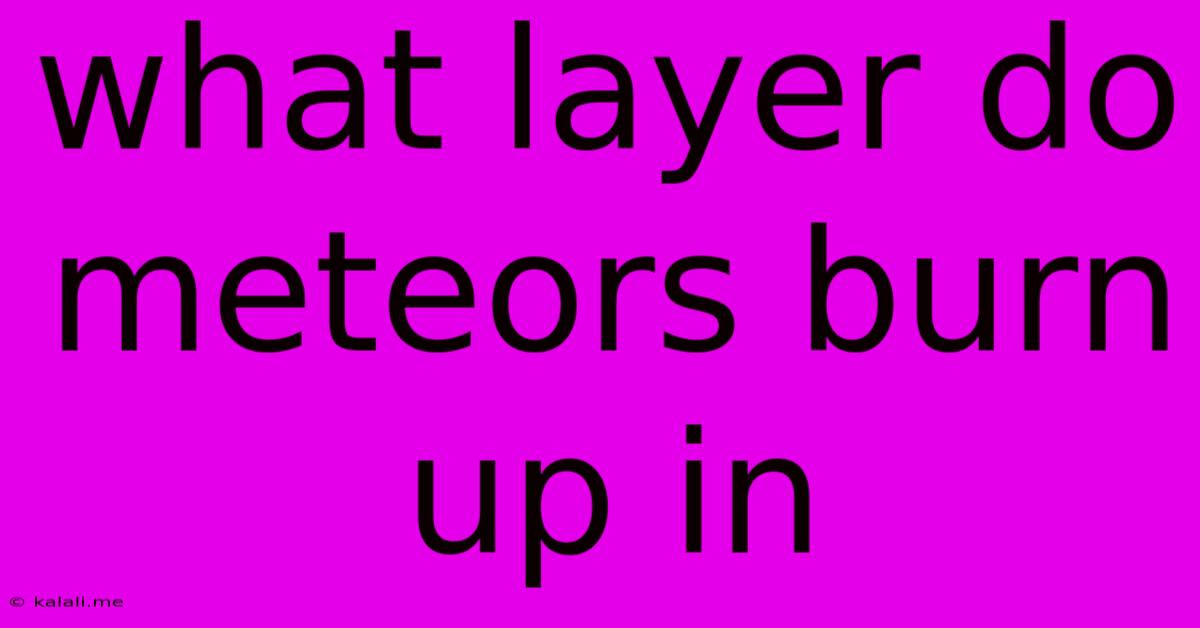What Layer Do Meteors Burn Up In
Kalali
Jun 15, 2025 · 3 min read

Table of Contents
What Layer Do Meteors Burn Up In? Understanding Meteor Ablation in the Earth's Atmosphere
Meteors, those fleeting streaks of light across the night sky, are a captivating celestial phenomenon. But have you ever wondered exactly where in the Earth's atmosphere these fiery visitors meet their demise? The answer isn't as simple as a single altitude, but rather a range determined by several factors. This article will delve into the atmospheric layer where meteors typically burn up, explaining the process and the variables involved.
Meta Description: Discover the atmospheric layer where meteors burn up and learn about the process of meteor ablation, influenced by factors like meteoroid size and composition.
The majority of meteors burn up in the mesosphere, specifically within the thermosphere and mesosphere, at altitudes ranging from approximately 80 to 100 kilometers (50 to 62 miles) above the Earth's surface. This is far above the troposphere, where weather occurs, and even above the stratosphere which contains the ozone layer.
The Process of Ablation
As meteoroids – small rocky or metallic bodies – enter the Earth's atmosphere at incredibly high speeds, they encounter increasing air density. This interaction generates intense friction, causing the meteoroid's surface to heat up dramatically. This heating process, known as ablation, causes the meteoroid to vaporize and ionize, creating the bright streak of light we see as a meteor.
The intense heat involved is capable of melting and vaporizing even the most robust meteoroids. The process isn't simply about friction alone; the compression of air in front of the meteoroid also contributes significantly to the extreme temperatures generated.
Factors Influencing Burning Altitude
While the mesosphere is the typical location, several factors influence the precise altitude at which a meteor burns up:
-
Size and Composition: Larger meteoroids possess greater inertia and can penetrate deeper into the atmosphere before completely ablating. Smaller meteoroids, on the other hand, may burn up at higher altitudes. The composition also plays a role; denser meteoroids will require more energy to ablate and thus may penetrate further.
-
Velocity: The speed at which a meteoroid enters the atmosphere is crucial. Higher velocities lead to more intense heating and faster ablation, potentially resulting in burning at higher altitudes.
-
Angle of Entry: A meteoroid entering at a steeper angle will encounter the atmosphere more directly, resulting in more rapid heating and a shorter trajectory. A shallower angle might result in a longer, lower-altitude burn.
-
Atmospheric Density: Variations in atmospheric density at different altitudes and locations affect the rate of ablation. Fluctuations in atmospheric density due to solar activity or other factors can slightly influence where a meteor burns up.
Beyond Burning Up: Meteor Showers and Fireballs
Most meteors completely ablate in the atmosphere, leaving no trace behind. However, larger meteoroids might not completely burn up, leaving fragments (meteorites) that can reach the Earth's surface. These are often associated with spectacular events called fireballs. Meteor showers, on the other hand, occur when Earth passes through a stream of debris left by a comet, causing numerous meteors to appear to radiate from a single point in the sky.
In conclusion, while the mesosphere is the primary atmospheric layer where meteors burn up, the exact altitude varies depending on a combination of factors related to the meteoroid itself and the atmospheric conditions. Understanding these factors provides a more complete picture of this awe-inspiring celestial event.
Latest Posts
Latest Posts
-
How To Find The Radius Of A Triangle
Jun 15, 2025
-
The Speed Of An Object In A Particular Direction
Jun 15, 2025
-
Oxidation Number Of Cr In K2cr2o7
Jun 15, 2025
-
Anything That Occupies Space And Has Mass Is Called
Jun 15, 2025
-
Line M Is Parallel To Line N
Jun 15, 2025
Related Post
Thank you for visiting our website which covers about What Layer Do Meteors Burn Up In . We hope the information provided has been useful to you. Feel free to contact us if you have any questions or need further assistance. See you next time and don't miss to bookmark.